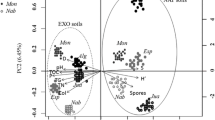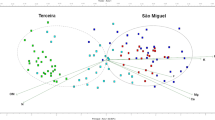Abstract
Knowledge of the changes in arbuscular mycorrhizal (AM) fungi is fundamental for understanding the success of exotic plant invasions in natural ecosystems. In this study, AM fungal colonization and spore community were examined along an invasive gradient of the exotic plant Eupatorium adenophorum in a secondary forest in southwestern China. With increasing E. adenophorum invasion, the density of arbuscules in the roots of E. adenophorum significantly increased, but the AM root colonization rate and the densities of vesicles and hyphal coils in roots of E. adenophorum were not significantly different. A total of 29 AM fungi belonging to nine genera were identified based on spore morphology. Claroideoglomus etunicatum, Funneliformis geosporus, and Glomus aggregatum were the most common AM fungal species. The E. adenophorum invasion significantly decreased the AM fungal spore density in the soil. Furthermore, with increasing of E. adenophorum invasion the spore densities of C. etunicatum, G. aggregatum, and G. arenarium significantly decreased, whereas F. geosporus significantly increased. Nonmetric multidimensional scaling demonstrated that the AM fungus community composition was significantly different (P=0.003) in the different invasive levels of E. adenophorum, and significantly correlated with plant species richness, soil total P, and soil NO3 −-N. The results suggest that the alteration in AM fungus community might be caused by E. adenophorum invasion via changing the local plant community and soil properties in a Chinese secondary forest ecosystem.
Similar content being viewed by others
References
Arthur, M.A., Bray, S.R., Kuchle, C.R., and McEwan, R.W. 2012. The influence of the invasive shrub, Lonicera maackii, on leaf decomposition and microbial community dynamics. Plant Ecol.213, 1571–1582.
Baruah, N.C., Sarma, J.C., Sarma, S., and Sharma, R.P. 1994. Seed germination and growth inhibitory cadinenes from Eupatorium adenophorum Spreng. J. Chem. Ecol.20, 1885–1892.
Batten, K.M., Scow, K.M., Davies, K.F., and Harrison, S.P. 2006. Two invasive plants alter soil microbial community composition in serpentine grasslands. Biol. Invasions8, 217–230.
Berch, S.M. and Kendrick, B. 1982. Vesicular-arbuscular mycorrhizae of southern Ontario ferns and fern-allies. Mycologia74, 769–776.
Bray, S.R., Kitajima, K., and Sylvia, D.M. 2003. Mycorrhizae differentially alter growth, physiology, and competitive ability of an invasive shrub. Ecol. Appl.13, 565–574.
Burrows, R.L. and Pfleger, F.L. 2002. Arbuscular mycorrhizal fungi respond to increasing plant diversity. Can. J. Bot.80, 120–130.
Callaway, R.M., Thelen, G.C., Rodriguez, A., and Holben, W.E. 2004. Soil biota and exotic plant invasion. Nature427, 731–733.
Daniels, B.A. and Skipper, H.D. 1982. Methods for the recovery and quantitative estimation of propagules from soil, pp. 29–35. In Schenck, N.C. (ed.), Methods and Principles of Mycorrhiza Research. American Phytopathology Society, St. Paul, Minnesota, USA.
Elgersma, K.J. and Ehrenfeld, J.G. 2011. Linear and non-linear impacts of a non-native plant invasion on soil microbial community structure and function. Biol. Invasions13, 757–768.
Eskelinen, A., Stark, S., and Männistö, M. 2009. Links between plant community composition, soil organic matter quality and microbial communities in contrasting tundra habitats. Oecologia161, 113–123.
Gerdemann, J.W. and Nicolson, T.H. 1963. Spores of mycorrhizal Endogone species extracted from soil by wet sieving and decanting. Trans. Brit. Mycol. Soc.46, 235–244.
Harner, M.J., Mummey, D.L., Stanford, J.A., and Rillig, M.C. 2010. Arbuscular mycorrhizal fungi enhance spotted knapweed growth across a riparian chronosequence. Biol. Invasions12, 1481–1490.
Hausmann, N.T. and Hawkes, C.V. 2009. Plant neighborhood control of arbuscular mycorrhizal community composition. New Phytol.183, 1188–1200.
Hawkes, C.V., Belnap, J., D’Antonio, C., and Firestone, M.K. 2006. Arbuscular mycorrhizal assemblages in native plant roots change in the presence of invasive exotic grasses. Plant Soil281, 369–380.
Ji, B.M., Bentivenga, S.P., and Casper, B.B. 2012. Comparisons of AM fungal spore communities with the same hosts but different soil chemistries over local and geographic scales. Oecologia168, 187–197.
Jin, L., Gu, Y.J., Xiao, M., Chen, J.K., and Li, B. 2004. The history of Solidago canadensis invasion and the development of its mycorrhizal associations in newly-reclaimed land. Funct. Plant Biol.31, 979–986.
Johnson, D., Vandenkoornhuyse, P.J., Leake, J.R., Gilbert, L., Booth, R.E., Grime, J.P., Young, J.P.W., and Read, D.J. 2004. Plant communities affect arbuscular mycorrhizal fungal diversity and community composition in grassland microcosms. New Phytol.161, 503–515.
Klironomos, J.N. 2002. Feedback with soil biota contributes to plant rarity and invasiveness in communities. Nature417, 67–70.
Koske, R.E. 1987. Distribution of VA mycorrhizal fungi along a latitudinal temperature gradient. Mycologia79, 55–68.
Koske, R.E. and Tessier, B. 1983. A convenient, permanent slide mounting medium. Mycol. Soc. Am. Newsl.34, 59.
Lankau, R.A. 2011. Resistance and recovery of soil microbial communities in the face of Alliaria petiolata invasions. New Phytol.189, 536–548.
Li, Y.P. and Feng, Y.L. 2009. Differences in seed morphometric and germination traits of crofton weed (Eupatorium adenophorum) from different elevations. Weed Sci.57, 26–30.
Liao, C.Z., Peng, R.H., Luo, Y.Q., Zhou, X.H., Wu, X.W., Fang, C.M., Chen, J.K., and Li, B. 2008. Altered ecosystem carbon and nitrogen cycles by plant invasion: a meta-analysis. New Phytol.177, 706–714.
Lu, H.F., Shen, J.B., Sang, W.G., Zhang, X.Y., and Lin, J.X. 2008. Pollen viability, pollination, seed set, and seed germination of croftonweed (Eupatorium adenophorum) in China. Weed Sci.56, 42–51.
McGonigle, T.P., Miller, M.H., Evans, D.G., Fairchild, G.L., and Swan, J.A. 1990. A new method which gives an objective measure of colonization of roots by vesicular-arbuscular mycorrhizal fungi. New Phytol.115, 495–501.
Mummey, D.L. and Rillig, M.C. 2006. The invasive plant species Centaurea maculosa alters arbuscular mycorrhizal fungal communities in the field. Plant Soil288, 81–90.
Oehl, F., Laczko, E., Bogenrieder, A., Stahr, K., Bösch, R., van der Heijden, M., and Sieverding, E. 2010. Soil type and land use intensity determine the composition of arbuscular mycorrhizal fungal communities. Soil Biol. Biochem.42, 724–738.
Oksanen, J., Kindt, R., Legendre, P., O’Hara, B., Simpson, G.L., Solymos, P., Stevens, M.H.H., and Wagner, H. 2009. Vegan: community ecology package. R package version 1.15–2. Available at: http://vegan.r-forge.r-project.org/.
Pejchar, L. and Mooney, H.A. 2009. Invasive species, ecosystem services and human well-being. Trends Ecol. Evol.24, 497–504.
Pielou, E.C. 1975. Ecological Diversity. John Wiley & Sons Inc., New York, USA.
R Development Core Team. 2011. R: a Language and Environment for Statistical Computing. R Foundation for Statistical Computing, Vienna, Austria.
Sanon, A., Béguiristain, T., Cébron, A., Berthelin, J., Ndoye, I., Leyval, C., Sylla, S., and Duponnois, R. 2009. Changes in soil diversity and global activities following invasions of the exotic invasive plant, Amaranthus viridis L., decrease the growth of native sahelian Acacia species. FEMS Microbiol. Ecol.70, 118–131.
Schenck, N.C. and Pérez, Y. 1990. A Manual for Identification of Vesicular Arbuscular Mycorrhizal Fungi, INVAM, 3rd ed. University of Florida, Gainsville, Florida, USA.
Scheublin, T.R., van Logtestijn, R.S.P., and van der Heijden, M.G.A. 2007. Presence and identity of arbuscular mycorrhizal fungi influence competitive interactions between plant species. J. Ecol.95, 631–638.
Smith, S.E. and Read, D. 2008. Mycorrhizal Symbiosis, 3rd ed. Academic Press, New York, USA.
Stampe, E.D. and Daehler, C.C. 2003. Mycorrhizal species identity affects plant community structure and invasion: a microcosm study. Oikos100, 362–372.
Stinson, K.A., Campbell, S.A., Powell, J.R., Wolfe, B.E., Callaway, R.M., Thelen, G.C., Hallett, S.G., Prati, D., and Klironomos, J.N. 2006. Invasive plant suppresses the growth of native tree seedlings by disrupting belowground mutualisms. PLoS Biol.4, 727–731.
Sun, X.Y., Lu, Z.H., and Sang, W.G. 2004. Review on studies of Eupatorium adenophorum — an important invasive species in China. J. Forest Res.15, 319–322.
van der Heijen, M.G.A., Bardgett, R.D., and van Straalen, N.M. 2008. The unseen majority: soil microbes as drivers of plant diversity and productivity in terrestrial ecosystems. Ecol. Lett.11, 296–310.
Vogelsang, K.M. and Bever, J.D. 2009. Mycorrhizal densities decline in association with nonnative plants and contribute to plant invasion. Ecology90, 399–407.
Wan, F.H., Liu, W.X., Guo, J.Y., Qiang, S., Li, B.P., Wang, J.J., Yang, G.Q., Niu, H.B., Gui, F.R., Huang, W.K., andet al. 2010. Invasive mechanism and control strategy of Ageratina adenophora (Sprengel). Sci. China Life Sci.53, 1291–1298.
Wilson, G.W.T., Hickman, K.R., and Williamson, M.M. 2012. Invasive warm-season grasses reduce mycorrhizal root colonization and biomass production of native prairie grasses. Mycorrhiza22, 327–336.
Wolfe, B.E. and Klironomos, J.N. 2005. Breaking new ground: soil communities and exotic plant invasion. Bioscience55, 477–487.
Xu, C.W., Yang, M.Z., Chen, Y.J., Chen, L.M., Zhang, D.Z., Mei, L., Shi, Y.T., and Zhang, H.B. 2012. Changes in non-symbiotic nitrogen-fixing bacteria inhabiting rhizosphere soils of an invasive plant Ageratina adenophora. Appl. Soil Ecol. 54, 32–38.
Yu, X.J., Yu, D., Lu, Z.J., and Ma, K.P. 2005. A new mechanism of invader success: exotic plant inhibits natural vegetation restoration by changing soil microbe community. Chinese Sci. Bull.50, 1105–1112.
Zhang, F.J., Guo, J.Y., Chen, F.X., Liu, W.X., and Wan, F.H. 2012. Identification of volatile compounds released by leaves of the invasive plant croftonweed (Ageratina adenophora, Compositae), and their inhibition of rice seedling growth. Weed Sci.60, 205–211.
Zhang, Q., Yang, R.Y., Tang, J.J., Yang, H.S., Hu, S.J., and Chen, X. 2010. Positive feedback between mycorrhizal fungi and plants influences plant invasion success and resistance to invasion. PLoS ONE5, e12380.
Zhang, Q., Yao, L.J., Yang, R.Y., Yang, X.Y., Tang, J.J., and Chen, X. 2007. Potential allelopathic effects of an invasive species Solidago canadensis on the mycorrhizae of native plant species. Allelopathy J.20, 71–77.
Zhao, Y.J., Yang, X.J., Xi, X.Q., Gao, X.M., and Sun, S.C. 2012. Phenotypic plasticity in the invasion of Crofton weed (Eupatorium adenophorum) in China. Weed Sci.60, 431–439.
Zhou, Z.X., Jiang, H., Yang, C., Yang, M.Z., and Zhang, H.B. 2010. Microbial community on healthy and diseased leaves of an invasive plant Eupatorium adenophorum in southwest China. J. Microbiol.48, 139–145.
Author information
Authors and Affiliations
Corresponding author
Additional information
Supplemental material for this article may be found at http://www.springerlink.com/content/120956.
Electronic supplementary material
Rights and permissions
About this article
Cite this article
Sun, X., Gao, C. & Guo, LD. Changes in arbuscular mycorrhizal fungus community along an exotic plant Eupatorium adenophorum invasion in a chinese secondary forest. J Microbiol. 51, 295–300 (2013). https://doi.org/10.1007/s12275-013-3169-7
Received:
Accepted:
Published:
Issue Date:
DOI: https://doi.org/10.1007/s12275-013-3169-7




